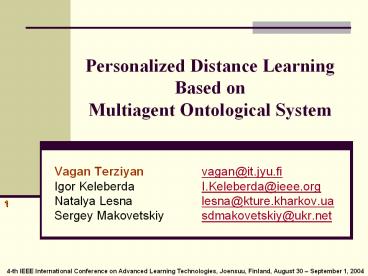Personalized Distance Learning Based on Multiagent Ontological System - PowerPoint PPT Presentation
1 / 24
Title:
Personalized Distance Learning Based on Multiagent Ontological System
Description:
Global Understanding eNvironment (GUN) GUN is an initiative of the Industrial Ontologies Group (IOG) ... the stage of registration. the stage of learning. 20 ... – PowerPoint PPT presentation
Number of Views:30
Avg rating:3.0/5.0
Title: Personalized Distance Learning Based on Multiagent Ontological System
1
Personalized Distance LearningBased
onMultiagent Ontological System
- Vagan Terziyan vagan_at_it.jyu.fi
- Igor Keleberda I.Keleberda_at_ieee.org
- Natalya Lesna lesna_at_kture.kharkov.ua
- Sergey Makovetskiy sdmakovetskiy_at_ukr.net
2
Authors
Igor Keleberda Department of Software
Engineering Kharkov National University of
Radioelectronics (Ukraine) http//poaslab.kture.kh
arkov.ua
Sergey Makovetskiy Department of Software
Engineering Kharkov National University of
Radioelectronics (Ukraine) http//poaslab.kture.kh
arkov.ua
Vagan Terziyan Industrial Ontologies
Group Department of Mathematical Information
Technologies University of Jyvaskyla
(Finland) http//www.cs.jyu.fi/ai/vagan
Natalya Lesna Educational and Methodical
Office Kharkov National University of
Radioelectronics (Ukraine)
This presentation http//www.cs.jyu.fi/ai/ICALT-2
004.ppt
3
Motivation (problem)
- The majority of modern distant learning systems
are characterized by usage of restricted set of
educational materials. - On the other hand, they provide insufficient
level of personalization of the learning process.
4
Motivation (solution)
- One possible way for overcoming mentioned
difficulties is the usage of multiagent software
technologies in the framework of the Semantic Web
activities of the W3? consortium. - These technologies are capable to automatically
extract necessary educational materials (disposed
over the whole Web space) to provide high-quality
personalization of the education.
5
What is Semantic Web ?
The Semantic Web is a vision the idea of
having data on the Web defined and linked in a
way that it can be used by machines not just for
display purposes, but for automation, integration
and reuse of data across various applications
6
Semantic Web New Users
applications
agents
7
Semantic Web What to Annotate ?
Industrial machines and devices
External world resources
Web resources / services / DBs / etc.
Web users (profiles, preferences)
Shared ontology
Web agents / applications
Web access devices
Educational resources
8
IEEE Learning Technology Standards
- 1484.12.1 IEEE Standard for Learning Object
Metadata (LOM) - 1484.12.3 Standard for XML binding for Learning
Object Metadata data model - 1484.12.4 Standard for Resource Description
Framework (RDF) binding for Learning Object
Metadata data model - P1484.2.1/D8 Draft Standard for Learning
Technology Public and Private Information
(PAPI) for Learners (PAPI Learner)
SW
9
Semantic Personalization
Learner
Agent-coordinator (semantic match engine)
Profile
Semantic annotation
Learning resource
10
Global Understanding eNvironment (GUN)
Resource
Agent
GUN
Metadata
Shared ontology
GUN is an initiative of the Industrial Ontologies
Group (IOG), lead with the goal of extending the
current Semantic Web to facilitate proactive,
goal-driven, self-maintained behavior of all
kinds of resources that can be adapted to the
Web. http//www.cs.jyu.fi/ai/OntoGroup/
11
Agents Proactive Behavior in GUN (1)
Able to make diagnostics of the learner and as
result to know recent profile of the learner
(learners state and condition) Knows target
profile (desirable state and condition according
to e.g. curriculum) Behaves to maintain the
learners state (i.e. to minimize the gap between
recent and target profiles) Able to discover and
utilize other resources and services to reach own
goals .
12
Agents Proactive Behavior in GUN (2)
Able to check access rights to appropriate
information Behaves to maximize the benefit for
the commercial use of information from the
resource Able to navigate external reader within
the resource.
13
From Web-Based Learning
WWW
14
to GUN-Based Learning.
Semantic Web
WWW
15
Mechanism of personalization
OR
OR
OL
OR
PAPI Learner
LOM
OL ,OR
LOM
LOM
OR
OL
LOM
PAPI Learner
OR
LOM
OL , OR
Software agent
Metadata
Ontology
Learning Resource
Learner
Agent Communication Language
16
MOSPDL architecture
17
MOSPDL algorithm
- The MOSPDL algorithm contains the following
stages - user registers in the MOSPDL
- agent-coordinator sends query for educational
data profile - learning resources agent creates the query to
educational resources in the Internet - educational Internet-resources give metadata for
analysis of necessity of their usage in the
learning process
cont
18
MOSPDL algorithm
- agent-coordinator provides selection of
educational materials then it sends query for
needed educational materials - learning resources agent builds the set of
educational materials, which is recommended for
the student - the agent-coordinator sends the resulting set to
the personal agent the personal agent produces
multimedia learning output for the student
19
The personal agent
- The main task of the personal agent is creation
of the user profile. - Algorithmic structure of the software agent
contains the following stages - the stage of registration
- the stage of learning
20
The learning resources agent
- The learning resources agent plays the role of a
searching machine, which is capable to realize
search on several resources simultaneously. - Algorithmic structure of the software agent
contains the following stages - the stage of forming of the profiles for
educational materials - the stage of creation of the needed educational
materials set
21
The agent-coordinator
- The agent-coordinator fulfils functions of the
intermediary and realizes control over the
learning process in the MOSPDL. - Algorithmic structure of the agent-coordinator
contains the following stages - the stage of searching for educational materials
- the stage of individual selection of an
educational material
22
Distance learning portal
23
Learning resource
24
Conclusions
- The designed software system belongs to a new
generation of distributed systems of distant
Web-based learning, namely to multiagent
ontological systems based on Semantic Web. - The elaborated architecture and algorithm of
MOSPDL is intended to solve the task of
automation of the distant learning process, which
is oriented on utilizing ontological models of
student's profiles and learning resources
profiles.

